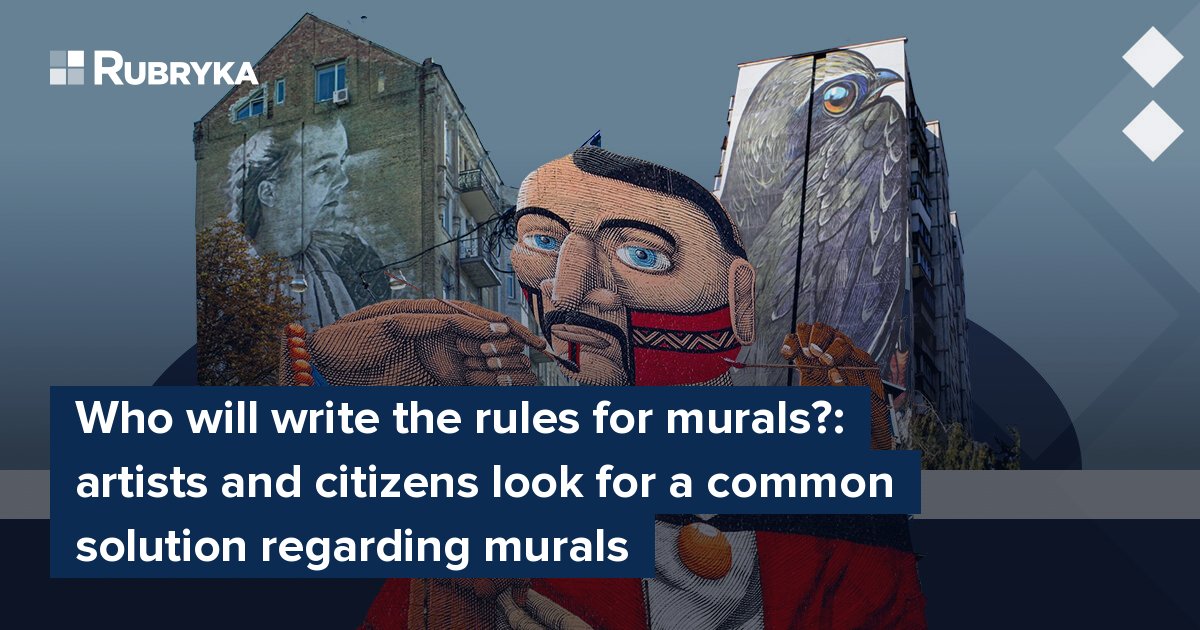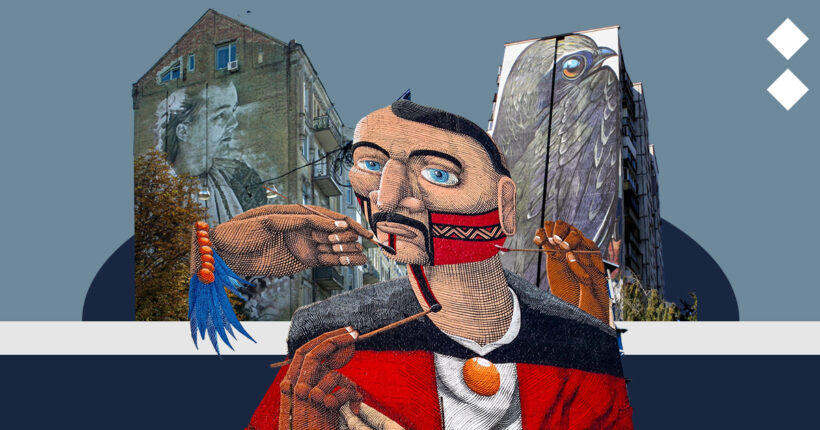
What is the problem?
"Stop mural damage to Kyiv" — a petition with such a call appeared on the page of electronic petitions of the Kyiv City Council. In 10 days, it collected almost half the required number of signatures for consideration. Within a month of its publication, it was already under consideration.
"Murals have become an inseparable feature of Kyiv. They enrich the cultural landscape of our city and influence its visual image," reads the text of the petition authored by Maria Vynogradova. Simultaneously, many conflicts arise in the city precisely because of the murals, their implementation, and their location. This is due to different perceptions of their artistic value and, most importantly, the opaque decision-making procedure regarding their creation.
Representatives usually make decisions regarding this or that mural of district state administrations without consultation with the community and the expert environment. There are frequent cases when even co-owners of buildings do not agree to the creation of a mural. The opinion of the people of Kyiv is simply ignored. The painting of murals on the walls of buildings with a protected status without prior approval from the Department of Cultural Heritage Protection causes particular indignation.
The city's residents often express serious concern about the lack of an open procedure for approving murals on the facades of buildings.
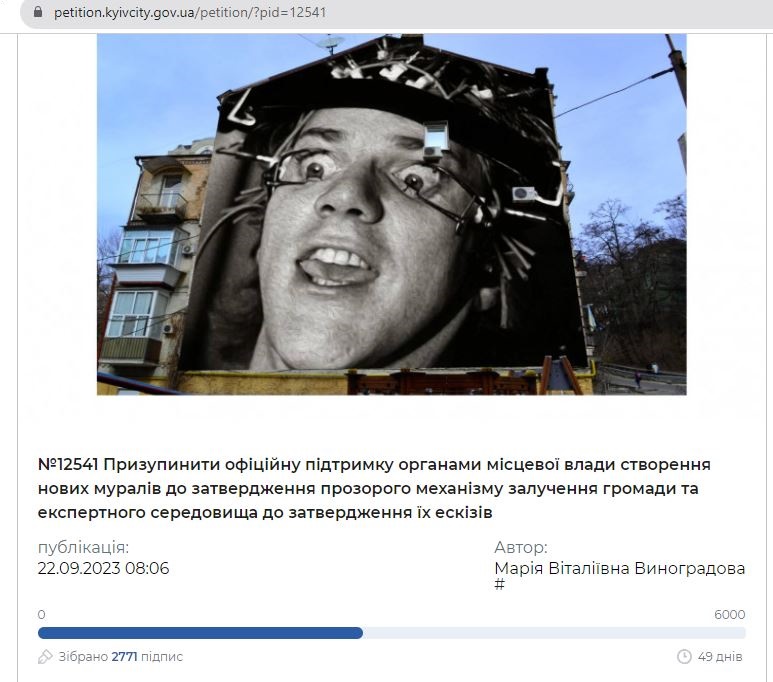
What's happening?
Murals provoke scandals
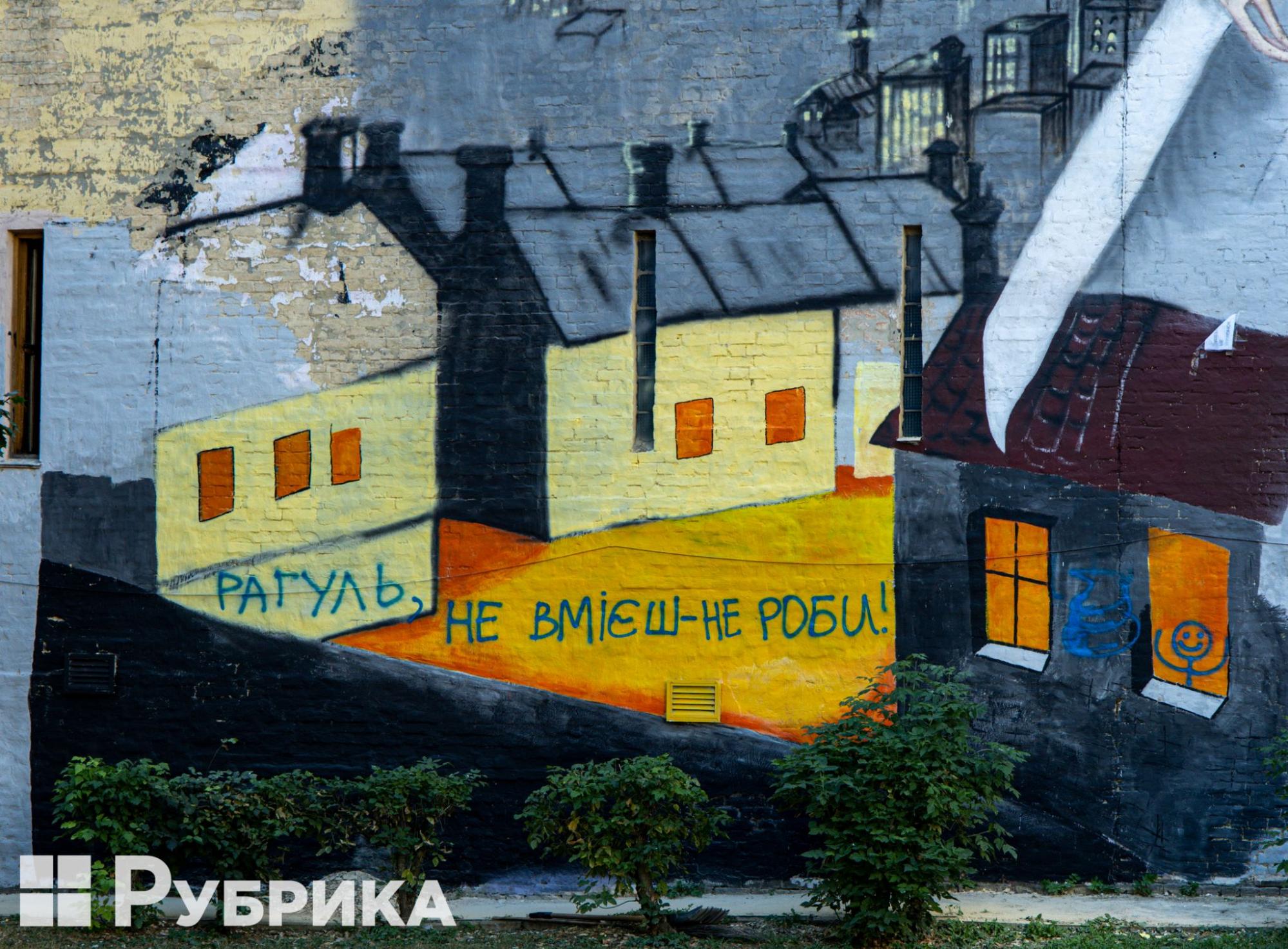
There is a scandalous inscription on an unfinished mural on 31 Sichovykh Striltsiv Street in Kyiv as of the beginning of October.
Over the past few months, several conflicting situations have arisen in the capital related to the creation of murals on the walls of residential buildings. In the first and most resonant case, some residents of a historic building opposed an image that a photo artist, Yevhenia Fullen, the author of social murals, wanted to apply to the wall. According to her concept, the mural featuring the heroes of Victor Hugo's "Notre Dame de Paris" was intended to symbolize Ukraine's gratitude to France for its military support of Ukraine.
However, an active part of the building's residents did not appreciate the embodiment of the idea, and the situation even escalated to the point of involving the police.
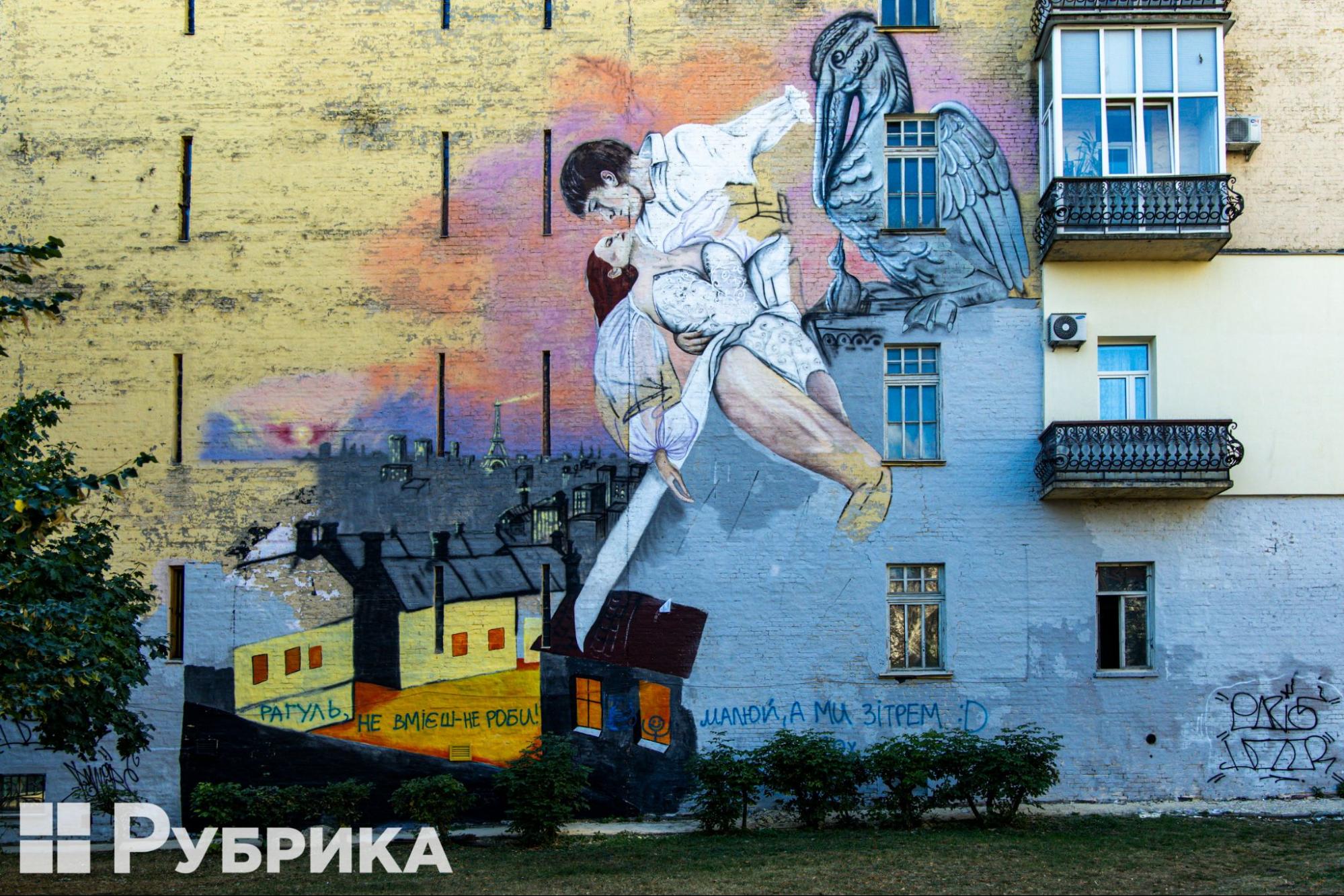
На першому, незавершеному варіанті стінопису Євгенії Фуллен — Квазімодо, що тримає Есмеральду
The first unfinished version of the mural by Fullen depicted Quasimodo holding Esmeralda. In support of the building's residents, Evheniia Kuleba, an official of the Kyiv City Council and founder of the non-governmental organization City-Garden, spoke out.
It was revealed that the building has a protective status, and any depiction on it without the city council's approval of the Department of Cultural Heritage Protection (DCHP) is not permitted.
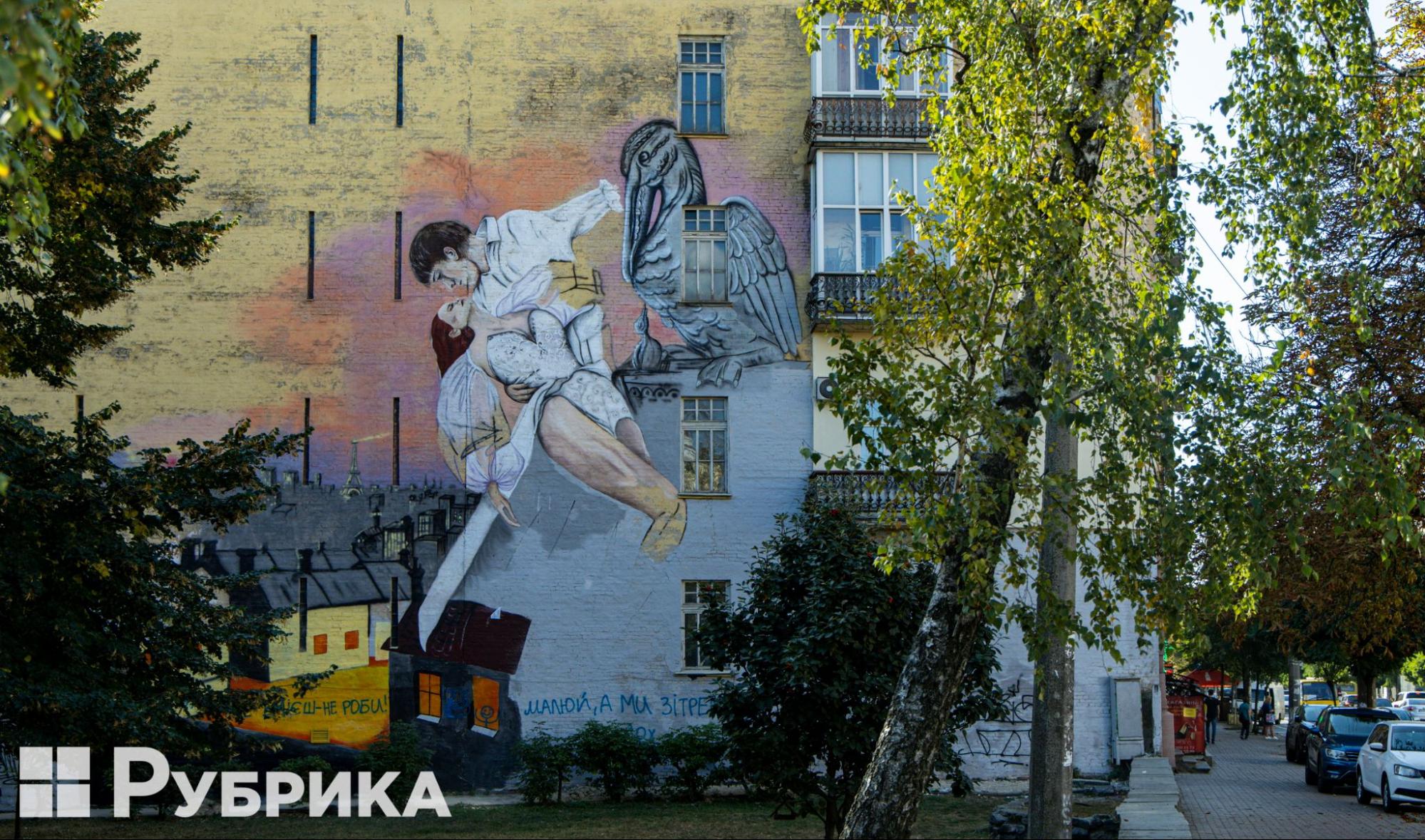
The mural at 31 Sichovykh Striltsiv Street.
However, that was not the end of the story. As of the beginning of October, the artist presented a new mural sketch on the theme of "Notre Dame de Paris" on social media, stating that it would appear on the same building as before, now with the consent of residents.
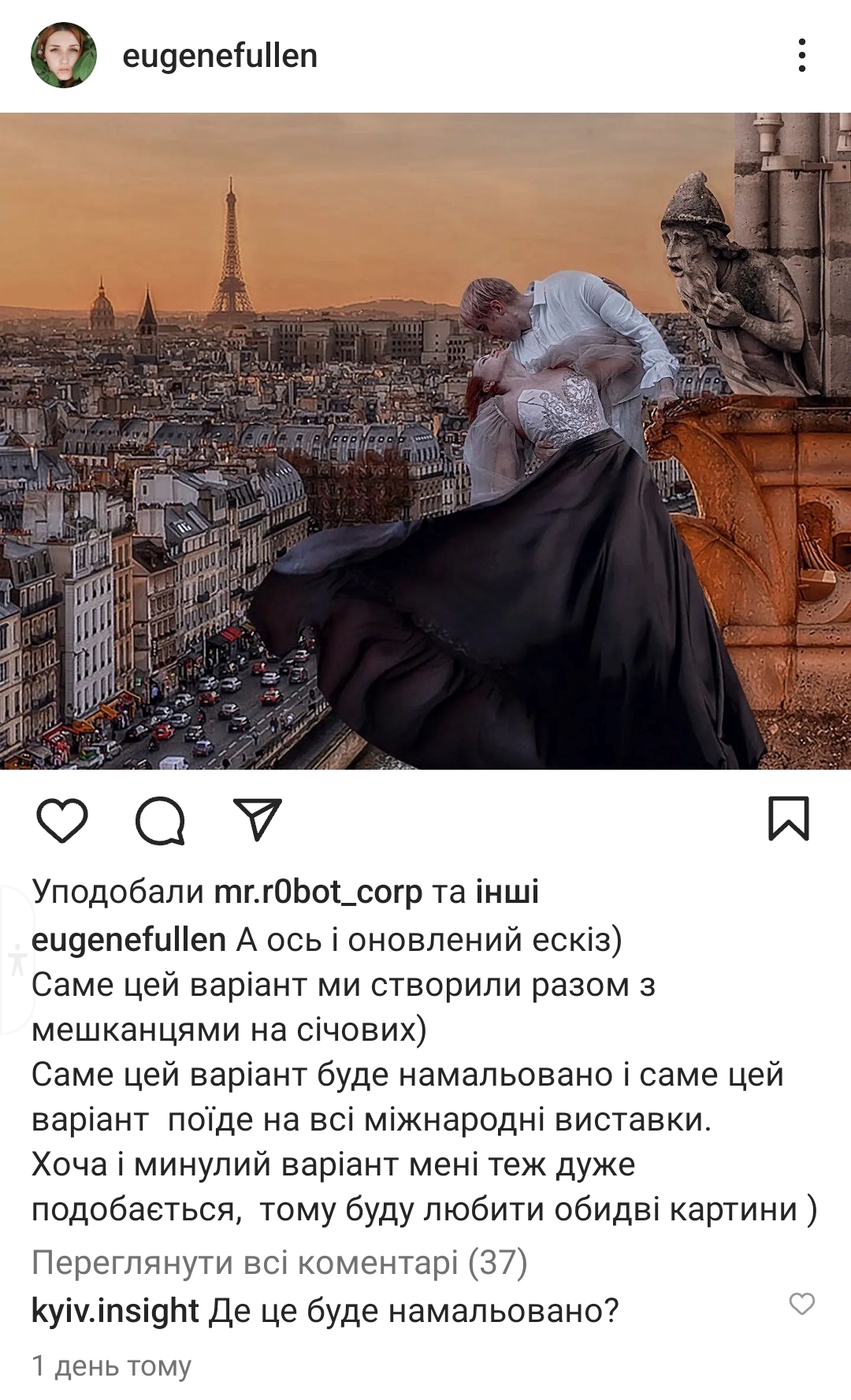
The screenshot is from Fullen's Instagram page.
Kuleba responded that neither the Department of Cultural Heritage Protection nor the Shevchenkivskyi District Administration, responsible for this building, had approved such work. Therefore, there is no legal permission. Thus, the deputy urged residents to call the police in case the work resumed.
On October 27, the Department of Cultural Heritage Protection advisory commission obliged the artist to cover the unapproved mural on Sichovykh Striltsiv Street at her own expense, Kuleba reported.
The aforementioned petition also became one of the results of this dispute. The petition was ardently supported by Kuleba herself, who promised to participate and involve the expert community in developing a transparent mechanism for creating murals.
The mural was intended to be painted over
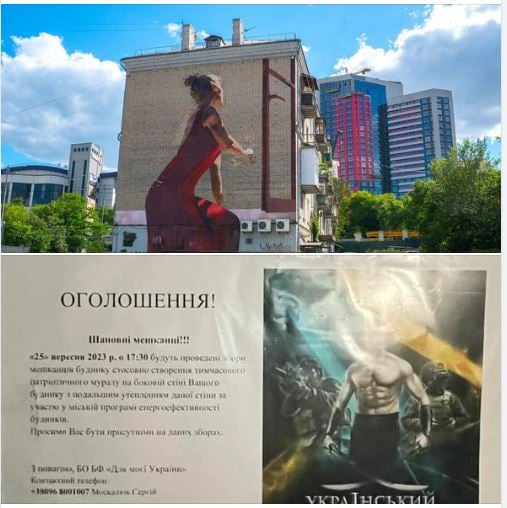
The screenshot is from Yevheniia Kuleba's Facebook page.
The second conflict occurred over a mural on 8 Lypkivskoho Street, near the central railway station. Instead of a mural by the Canadian author Emmanuel Jarus, the initiators from the For My Ukraine charitable foundation planned to create a mural with a Ukrainian character. According to the head of the fund, Serhii Moskaluk, the depiction of a Cossack and two soldiers was intended to support the military personnel arriving at the railway station. However, some residents felt that the mural contained hidden advertising for the Kozatska Rada vodka, which uses the slogan "Ukrainian character," leading to their outrage. The initiators stopped the project and had not resumed it at the time of writing this article.
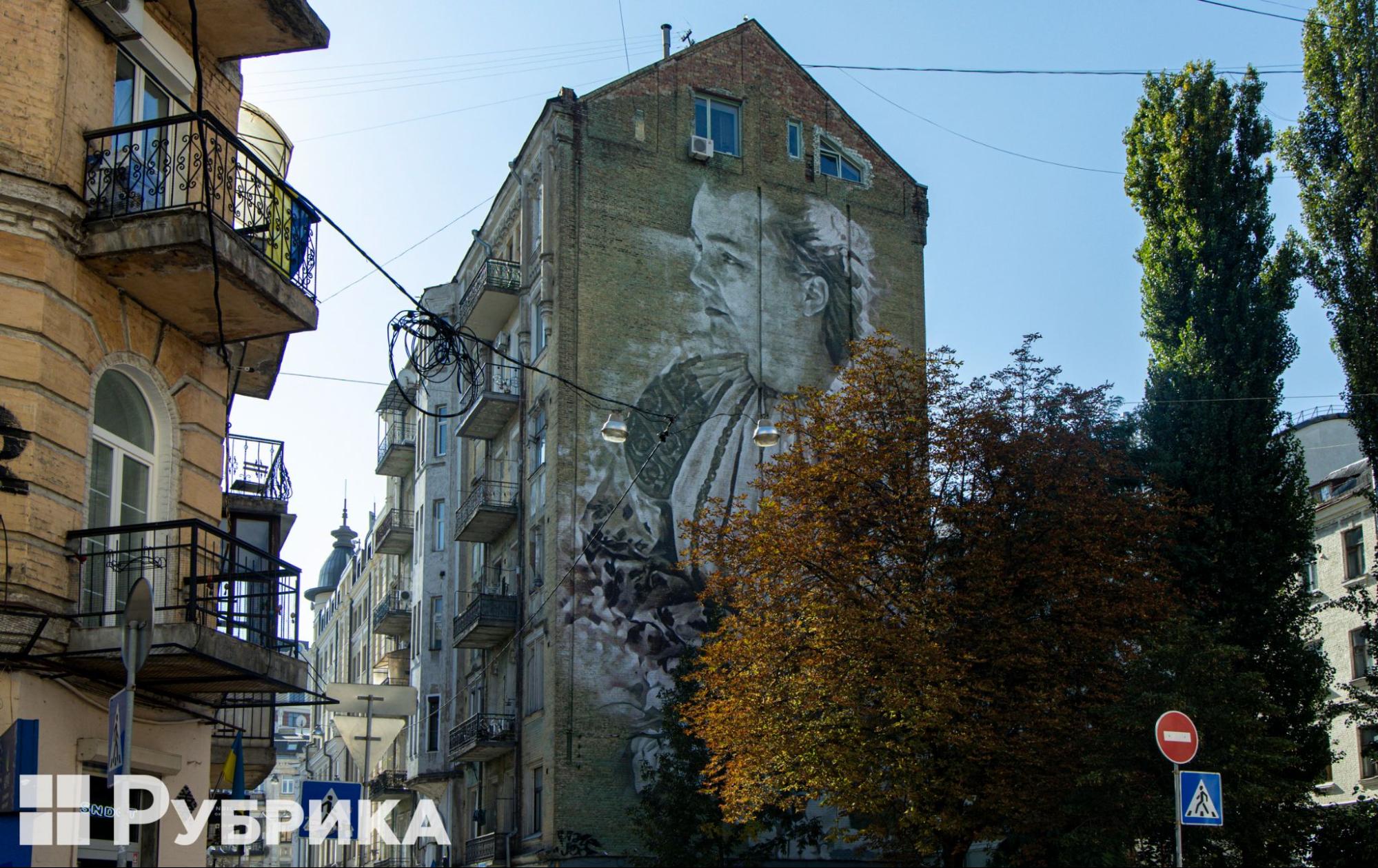
The mural "Lesya Ukrainka" (St. Striletska, 28), created by the Australian artist Guido van Helten in 2015.
What is the solution?
What the authors of the petition demand
Better communication, public discussions, and consultations
The authors of the petition demand the following:
1. Develop and approve at the local government level a regulation on "Approval of the creation of murals in Kyiv."
2. Establish an open process to involve the community and expert groups in the discussion and approval of murals.
3. Create an online platform or other communication means allowing the community to express their opinions and suggestions regarding murals.
4. Conduct consultations and public discussions on mural sketches before their approval.
5. Prohibit the creation of new murals on building facades until an open mechanism for engaging the community and experts is implemented.
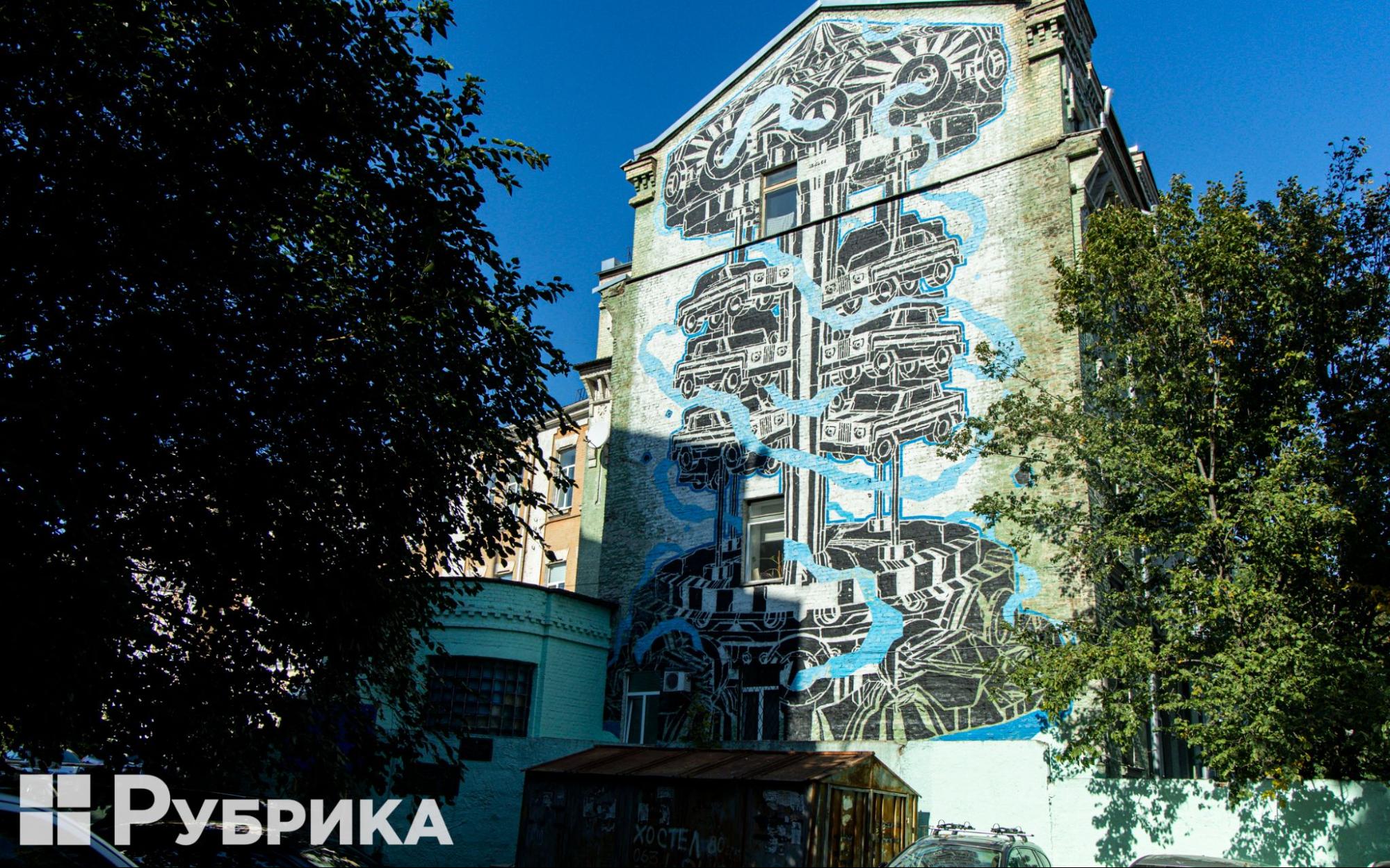
The mural "Carousel" (St. Striletska, 18), created in 2015 as part of the City Art project, by the Polish artist Mariusz Waras.
What do officials say?
It is necessary to obtain the consent of the building owner and adhere to the norms of urban improvement
Although not nationwide or city-wide for Kyiv, certain rules exist. For instance, in response to Rubryka's inquiry, the deputy head of the Shevchenkivskyi District State Administration, Oleh Chuzhdiuk, stated the conditions under which approval can be obtained for the creation of murals in the Shevchenkivskyi district of Kyiv:
- Approval can be obtained under the following conditions in the Shevchenkivskyi district of Kyiv:
- When there is permission from the Cabinet of Ministers of Ukraine or the relevant cultural heritage protection body, in the case where the building is an object of national or local cultural heritage significance;
- When the organizer has obtained consent from the building owner/company/institution/organization that has full economic responsibility or operational management of the building and adheres to this agreement by carrying out the work;
- When there is a control card issued by the Department of Territorial Control of the city of Kyiv's executive body, the Kyiv City State Administration (KCSA), for temporary violation of urban improvement, specifically for the change in the external appearance of the building facade;
- When the organizer has complied with all safety measures provided for by laws, the Rules of Urban Improvement of the city of Kyiv, and "other current regulatory legal acts."
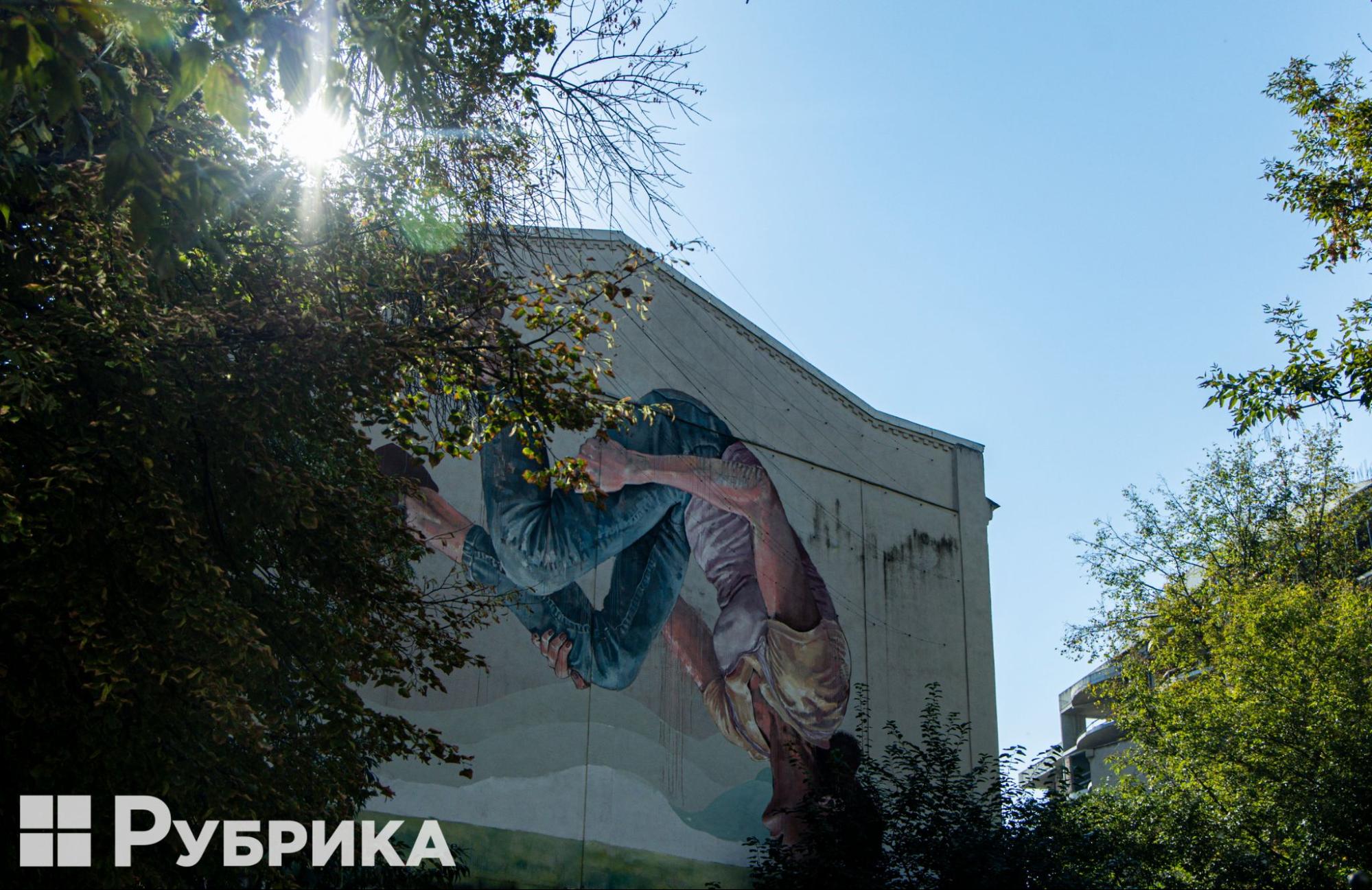
The mural featuring the gymnast Hanna Rizatdinova (St. Strel'etska, 12) was created in 2015 by the Australian artist Fintan Magee.
Is it really a solution?
What muralistics says
The solution lies in adhering to ethical standards and ensuring quality communication
The creative group Kailas-V, led by Yana Volk, has been involved in creating murals for over ten years. Their portfolio includes murals in Bakhmut, Enerhodar, Kharkiv, Cherkasy, Kyiv, and other cities.
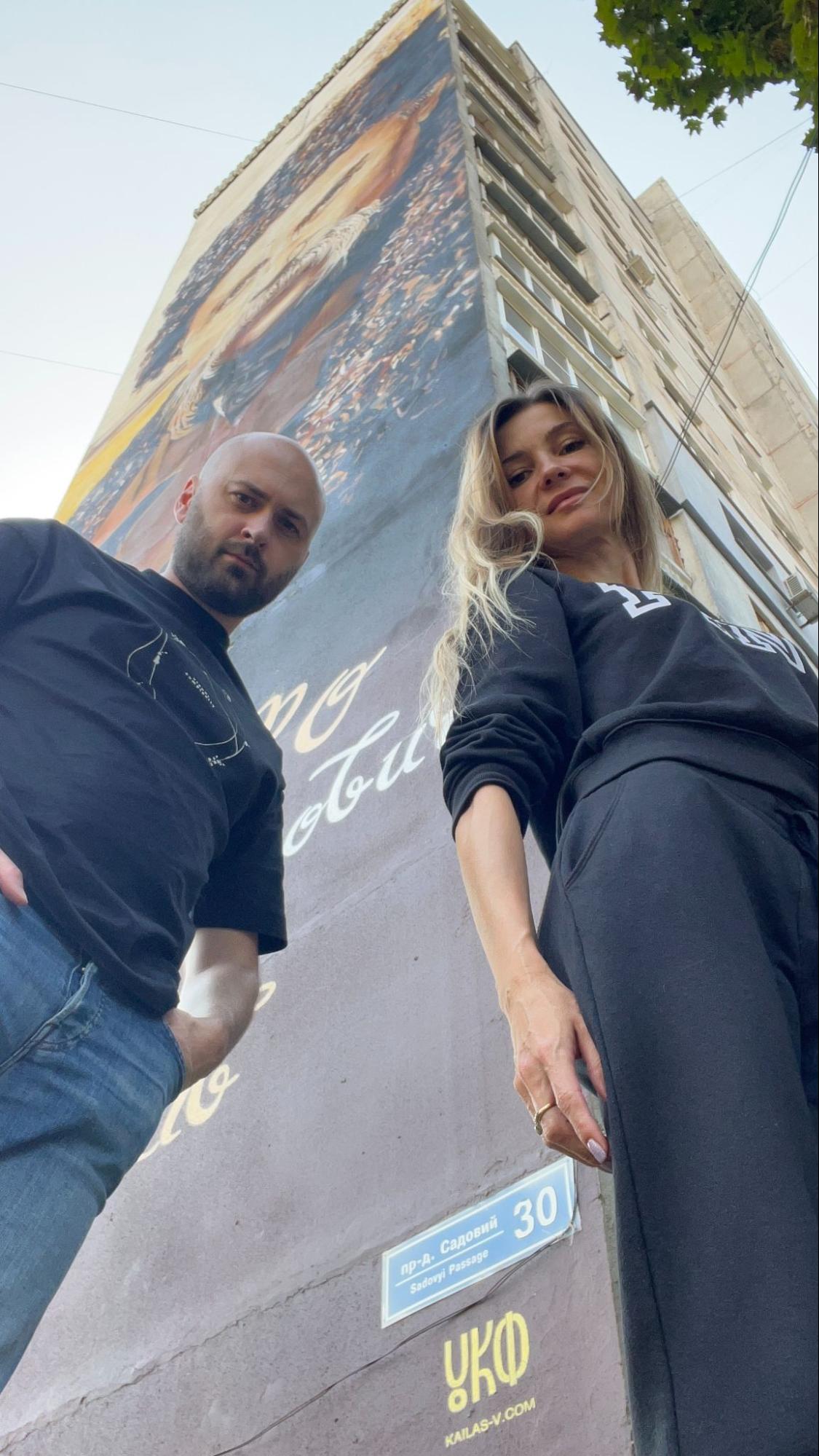
Yana Volk with her colleague Roman Partola against the backdrop of the work of the creative group/ Photo from Yana Volk's archive.
"While painting in the city, we primarily adhere to moral principles," says Volk. "Because your mural, for example, is seen by children going to school. And you probably wouldn't want your child to be frightened on the way to school. There are people of respectable age with their own reservations, and we also have to remember that."
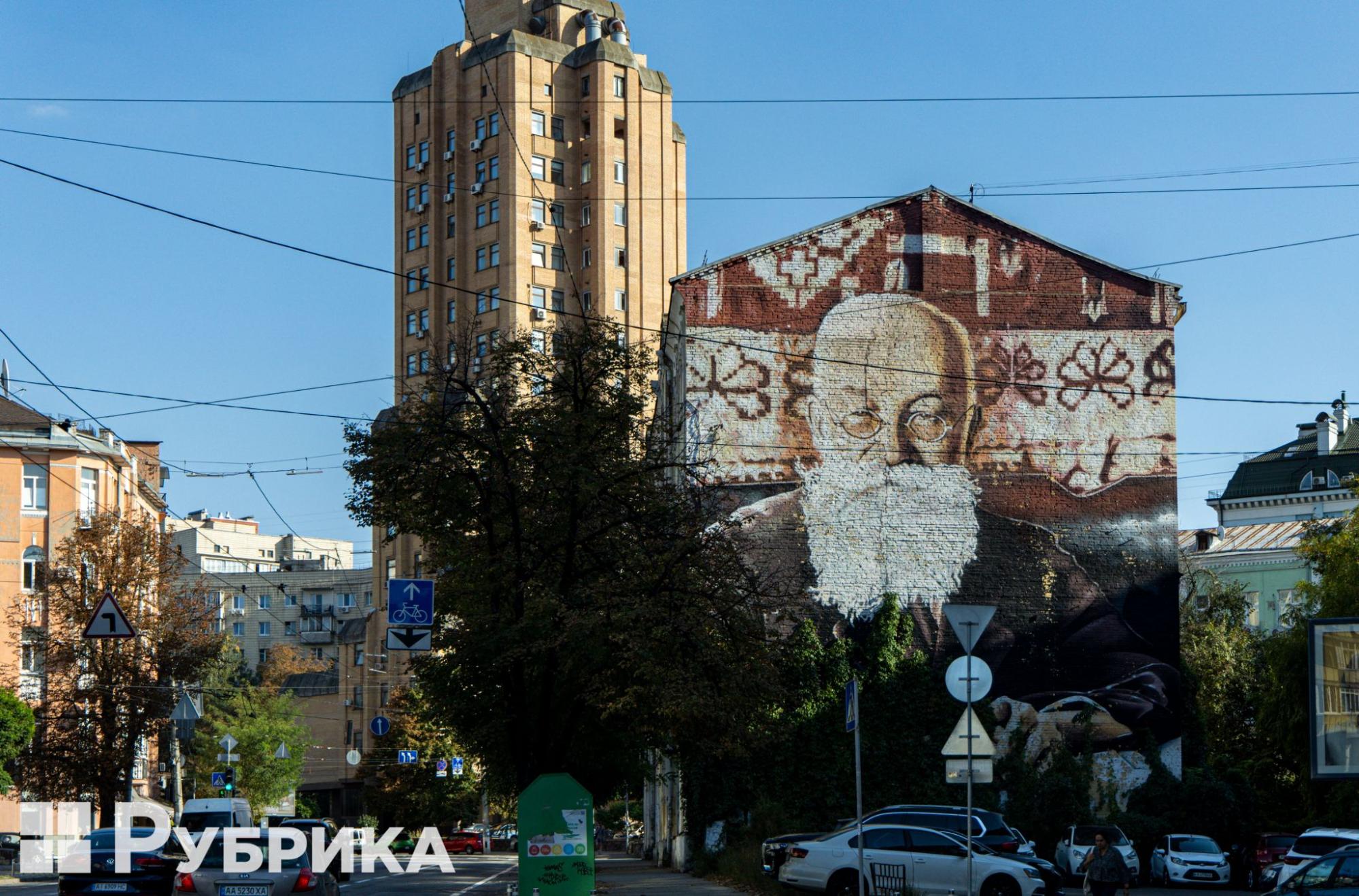
The mural "Mykhailo Hrushevsky" on 75 Sichovykh Striltsiv Street was painted in 2015 by the company Kailas-V on the occasion of the 150th anniversary of the first President of Ukraine.
How does it work?
Internal test with three questions
Volk offers to answer several questions before starting to create a mural. According to her, the first two are the most important:
Does your work attract/reflect negativity?
Does your work scare children and sensitive people?
Volk is convinced: "Muralists are not those who express their inner world. Muralists are those who work in public space. Public space is people. We work for people, no matter how pathetically it may sound. This should always be the starting point."

The mural "Red Bicycle" (13 Vyacheslav Lypynskyi str.) opposite the Kyiv bicycle track is a self-portrait of the Canadian artist Emmanuel Jarus, created in 2016.
If the answers to the first two questions are negative, the following occurs:
Can you draw?
"We have a 99% success rate in getting the mock-up right. We paint photographs that look alive. But, to be honest, we also have 'flaws' that I am still ashamed of and that we try not to repeat," says the head of the muralist group.
In other words, mistakes are possible, but a mural is not a work carved in stone; it has a lifespan of a maximum of five years. And if the paint is of poor quality, even less. If desired or necessary, it can be painted over by oneself, adds Yana Volk.
"Muralists are not artists. They come from graffiti. They mostly react reasonably when their work is painted over."
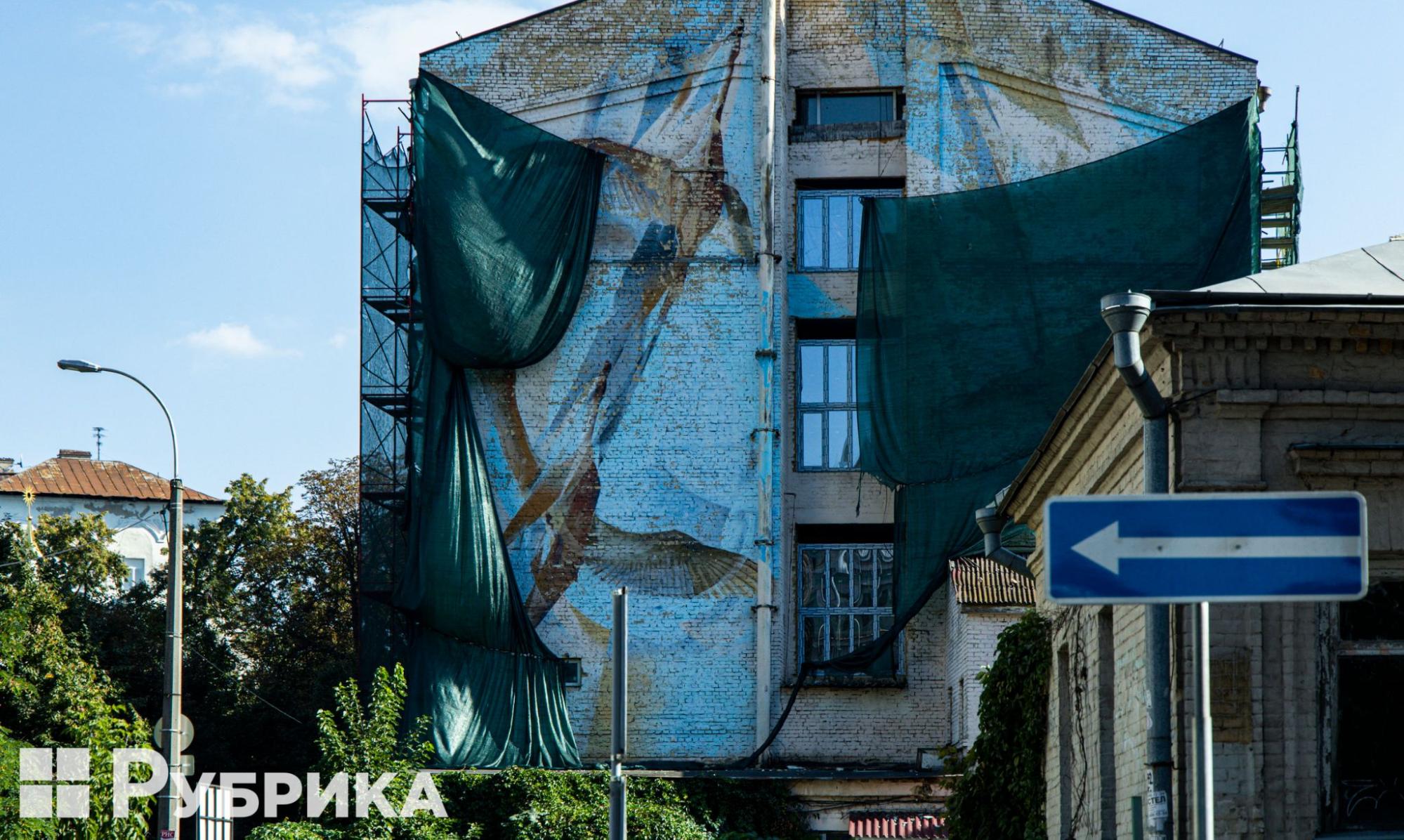
The mural (Georgiyivskyi Lane, 9), created in 2015 as part of the City Art project, was painted over with time by the Ukrainian artist Taras Arm.So, if the answer to the third question is affirmative, according to Volk, all further negotiations and obtaining permits will be more of a bureaucratic hassle.
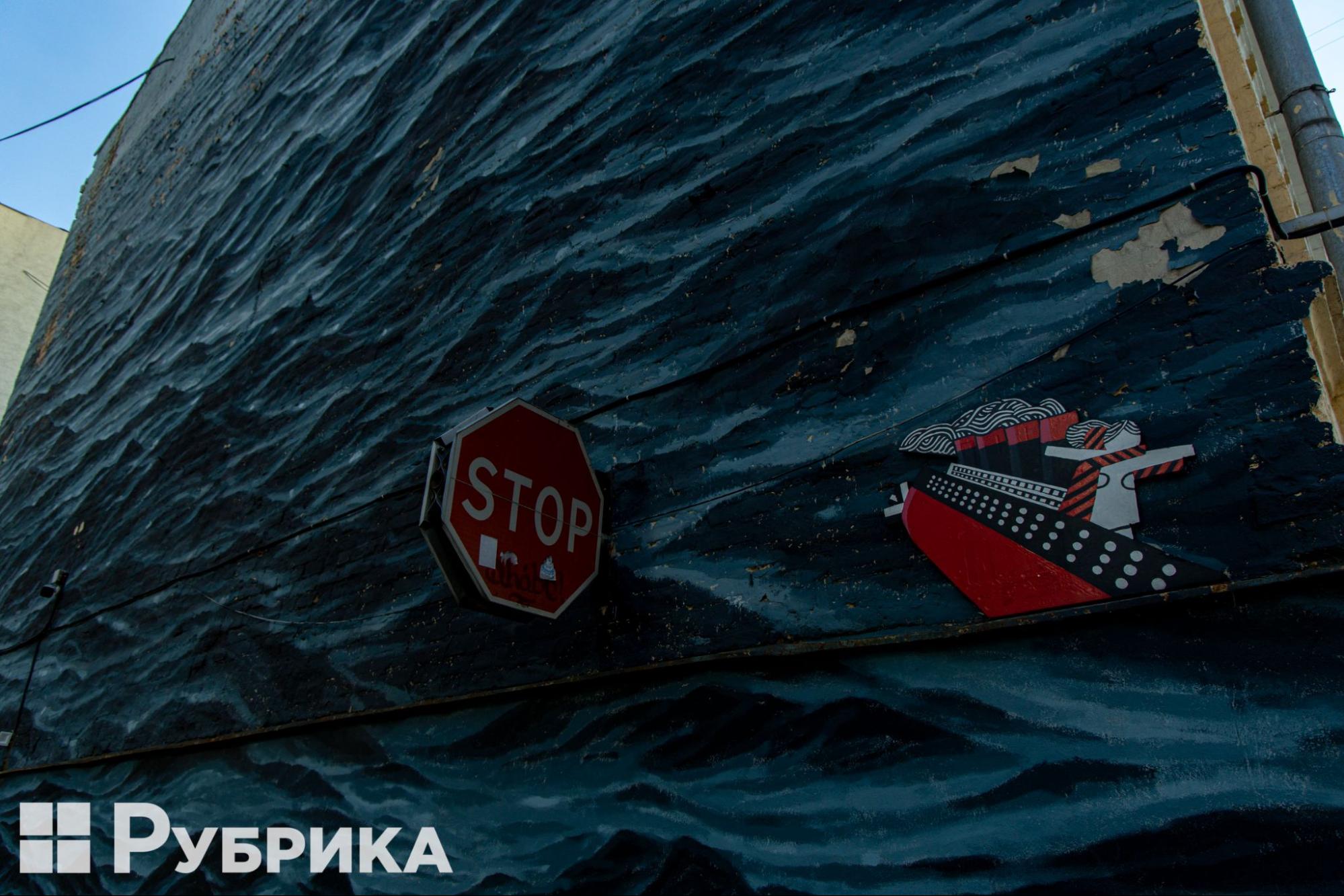
The mural "Ukrainian Black Sea" (Bulvarno-Kudryavska Street, 35) was created by the South African artist Jake Aikman in 2017.
If the requirement is to seek approval from city authorities, where does the confidence come from that the officials are knowledgeable about art? Just as it is often challenging to survey each resident of a hypothetical entrance, this is a cross-section of our society, where, according to the muralist, everyone has their own "taste."
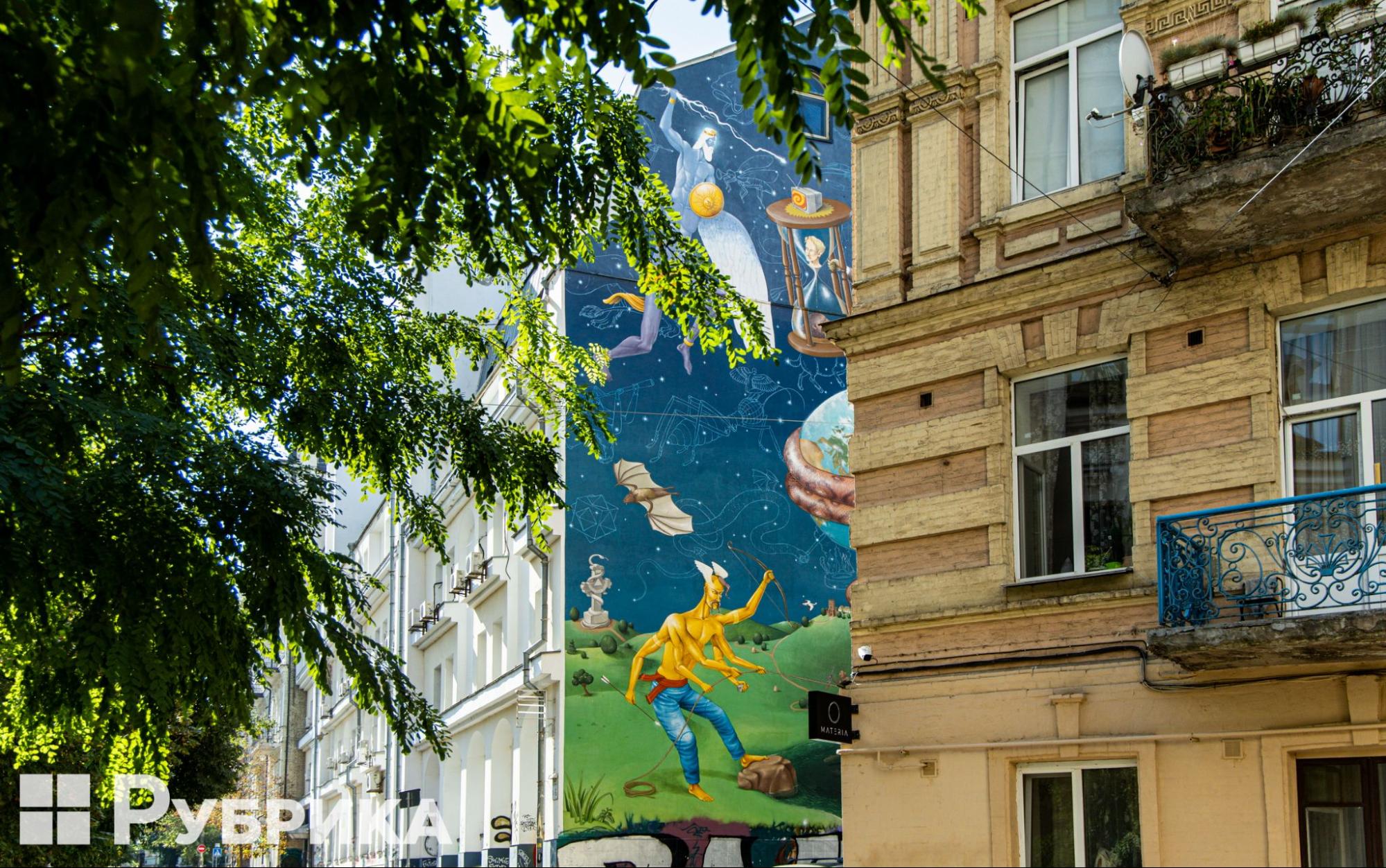
The mural "Time of Change" (St. Striletska, 6) was created in 2014 by the Ukrainian artists Interesni Kazki duo.
"It's good that we are different. And it is necessary to give opportunities to different people. The more you try to fit these people who try to do something into certain frameworks, the fewer decent works there will be. There will be decorative and provincial work. There will be nothing honest, nothing new," warns the head of the muralist group.
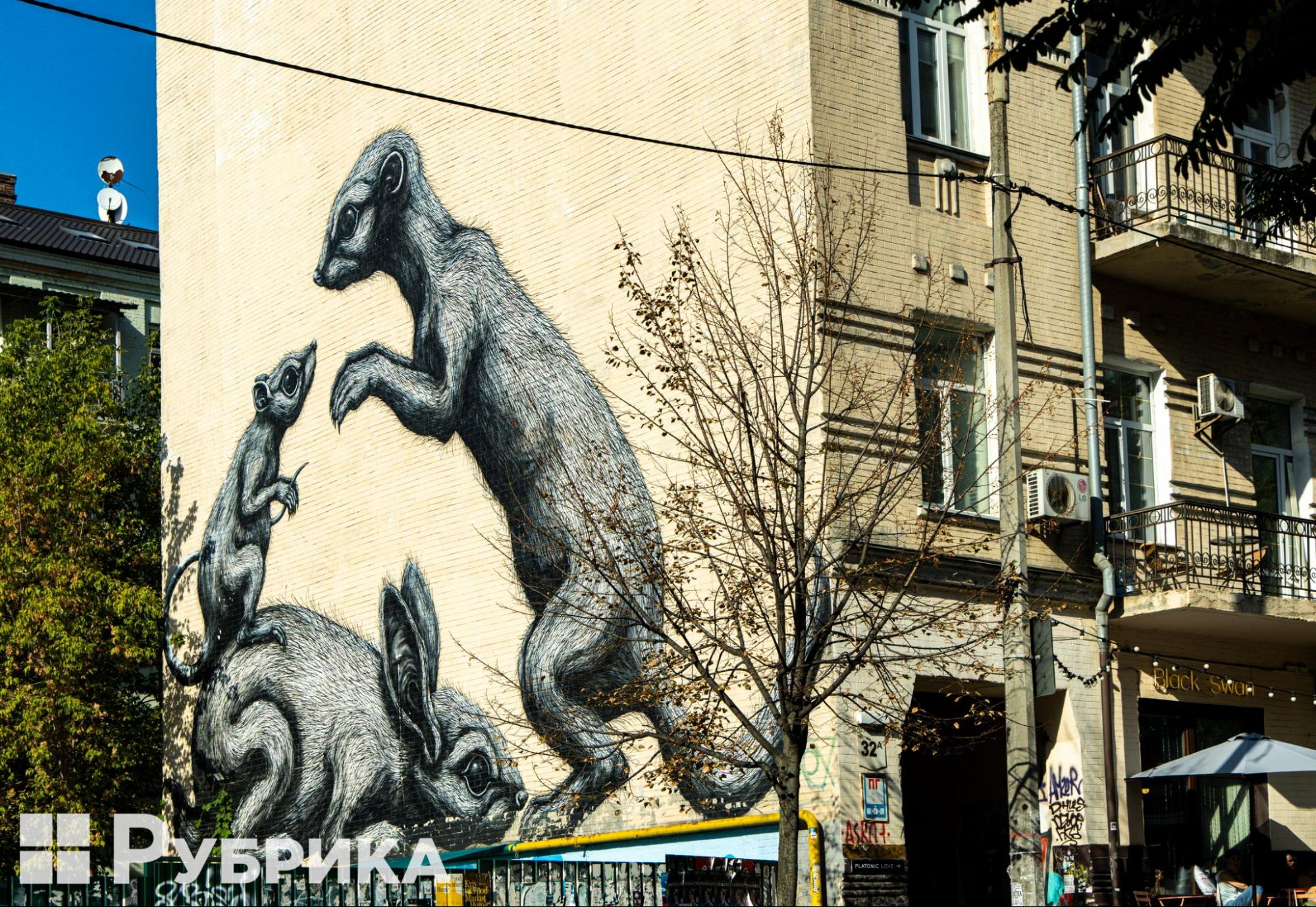
The mural "Rabbit, Rat, and Mongoose" (Oles Honchar Street, 32A) by the street artist Peter Roa from Belgium was created in 2016.
"We do not have a visual experience; it must be created. We must give artists a chance, even the clumsy ones. If they have found the money and are not painting explicit vulgarity, let them try," Volk belives.
Communicating with the residents is important
"If you are getting a slap in the face, it's also a natural market regulation process"
Volk shared her experience of creating a mural dedicated to animal adoption. The mural "Family for the Four-Legged" appeared in July 2023 in the Shevchenkivskyi district of the capital (Zlatoustivska Street, 23).
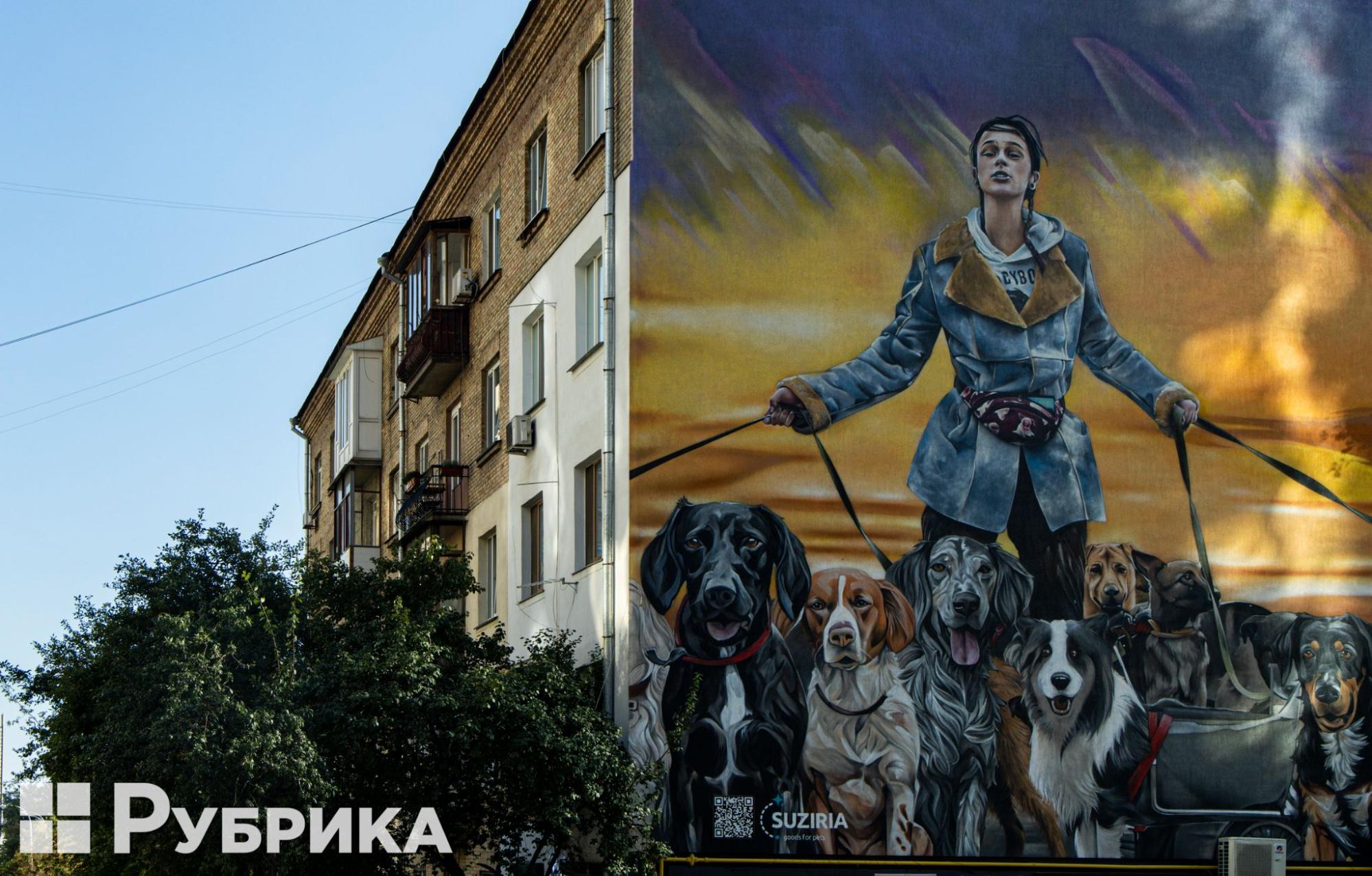
The main heroine of the mural was the zoo volunteer Anastasia Tykha, who, together with her husband, walked about 30 animals out of the war-torn city of Irpin.
Volk recounts: "I visited almost all the apartments where people were at that time. And they attacked me with words like, 'So, you'll paint on one side of the building, but who will paint on the other?' They also asked for the background to be beautiful."
The muralist is convinced that when you communicate and show people what you will paint, you will do what people want. In the end, you will remain the best of friends. But if you paint without consent or the painted work does not correspond to the agreed-upon, you will encounter trouble during the work, and you simply will not be allowed to finish it.
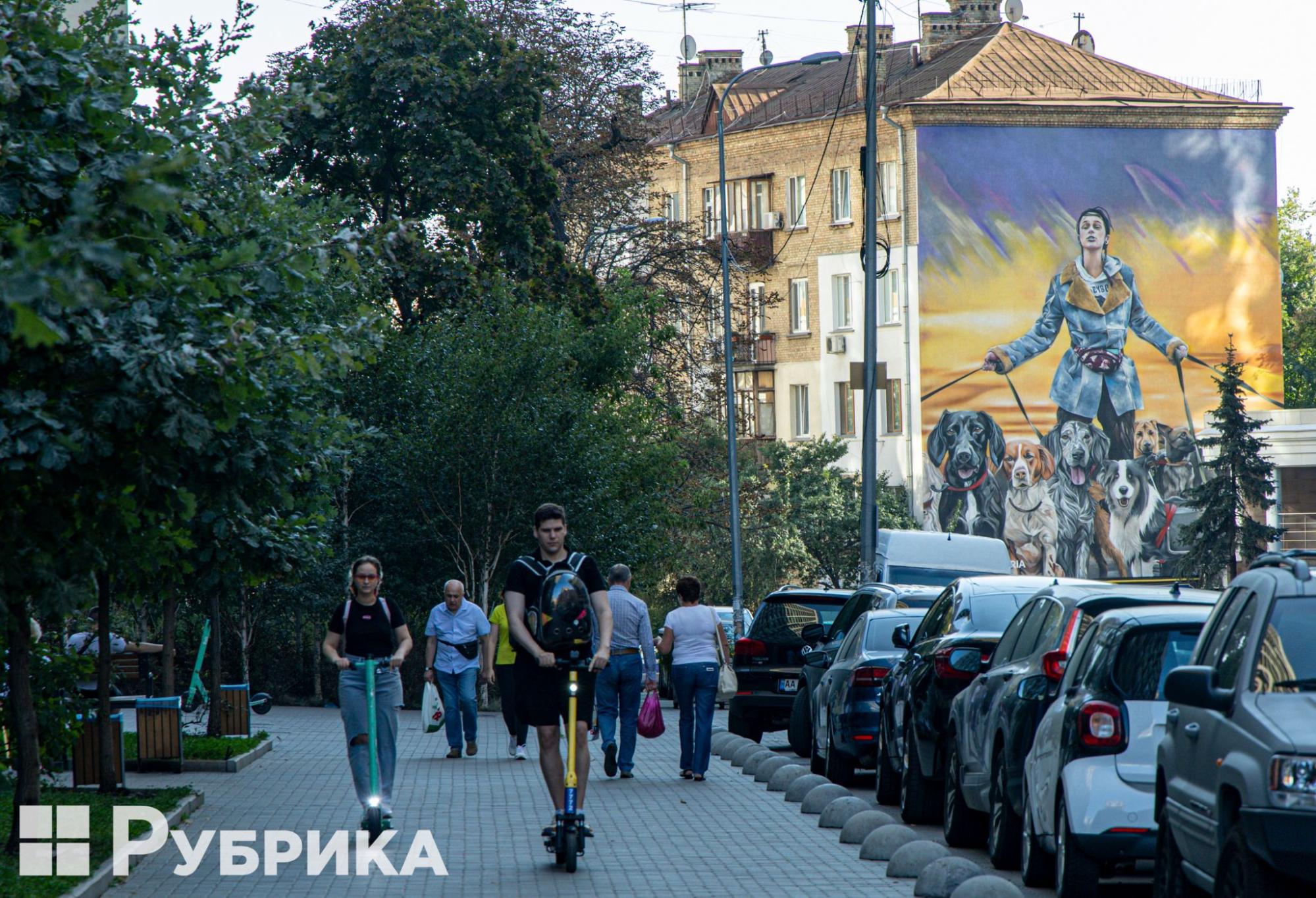
The mural "Family for the Four-Legged" (Zlatoustivska Street, 23) was created by the company Kailas-V in July 2023.
The head of the creative group also believes that the key to the project's success is a creative team, where each member has their own role. Someone communicates with all interested parties, and someone works on it so that the layout design has an adequate reflection on the wall. And there have to be artists who bring this to life.
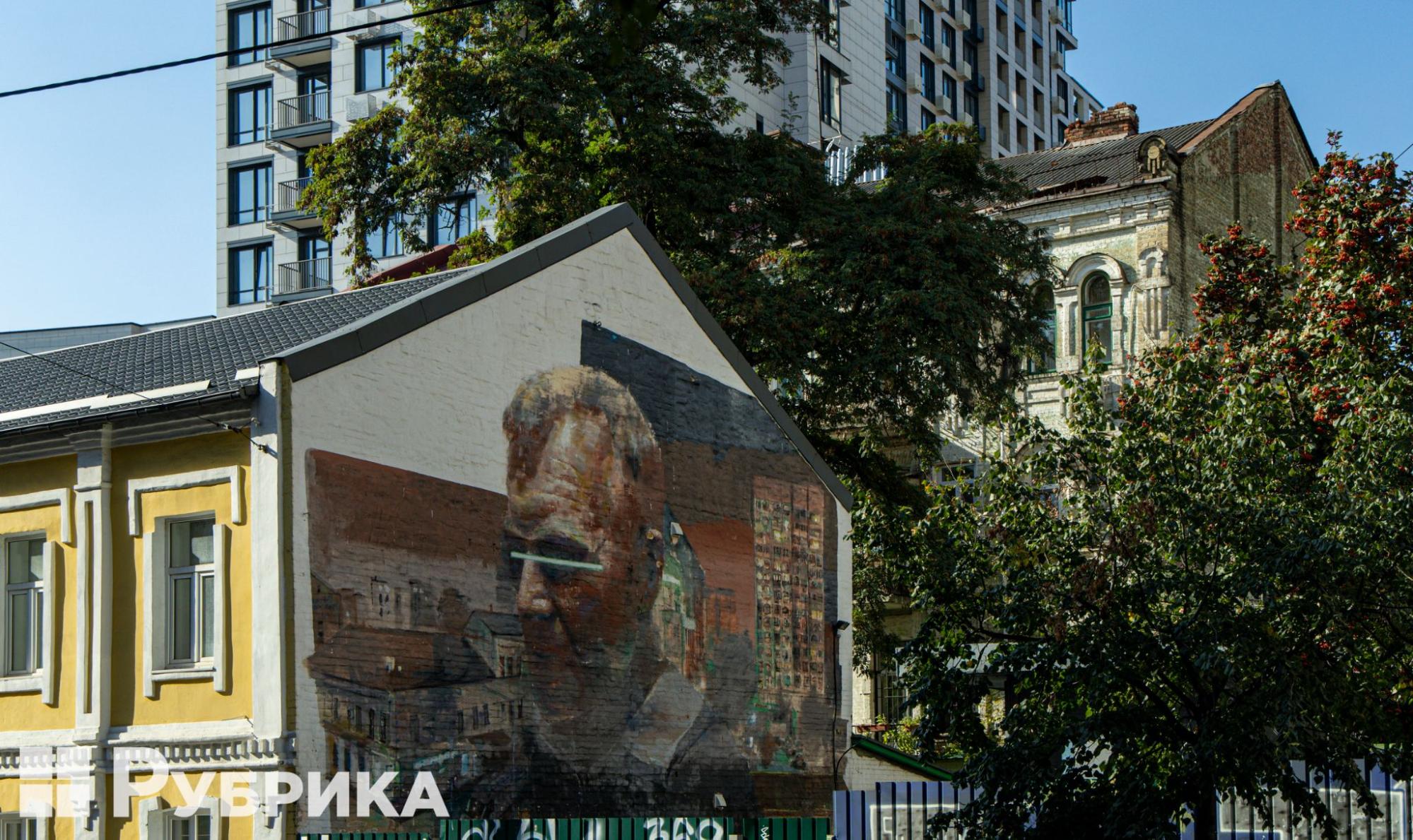
The mural (Oles Honchar Street, 36A) was created in 2016 as part of the Art United Us art project by the Spanish artist Sebas Velasco.
"If artists have curators, everything will be fine. If not, they will just get a slap on the wrist, and they won't paint anymore. Which is also a natural market regulation," concludes Volk.
What the art critic says
The decision is upon the expert boards
For art critic Yevheniia Molyar, the scandal surrounding the wall painting at Sichovi Striltsi, 31 is very revealing:
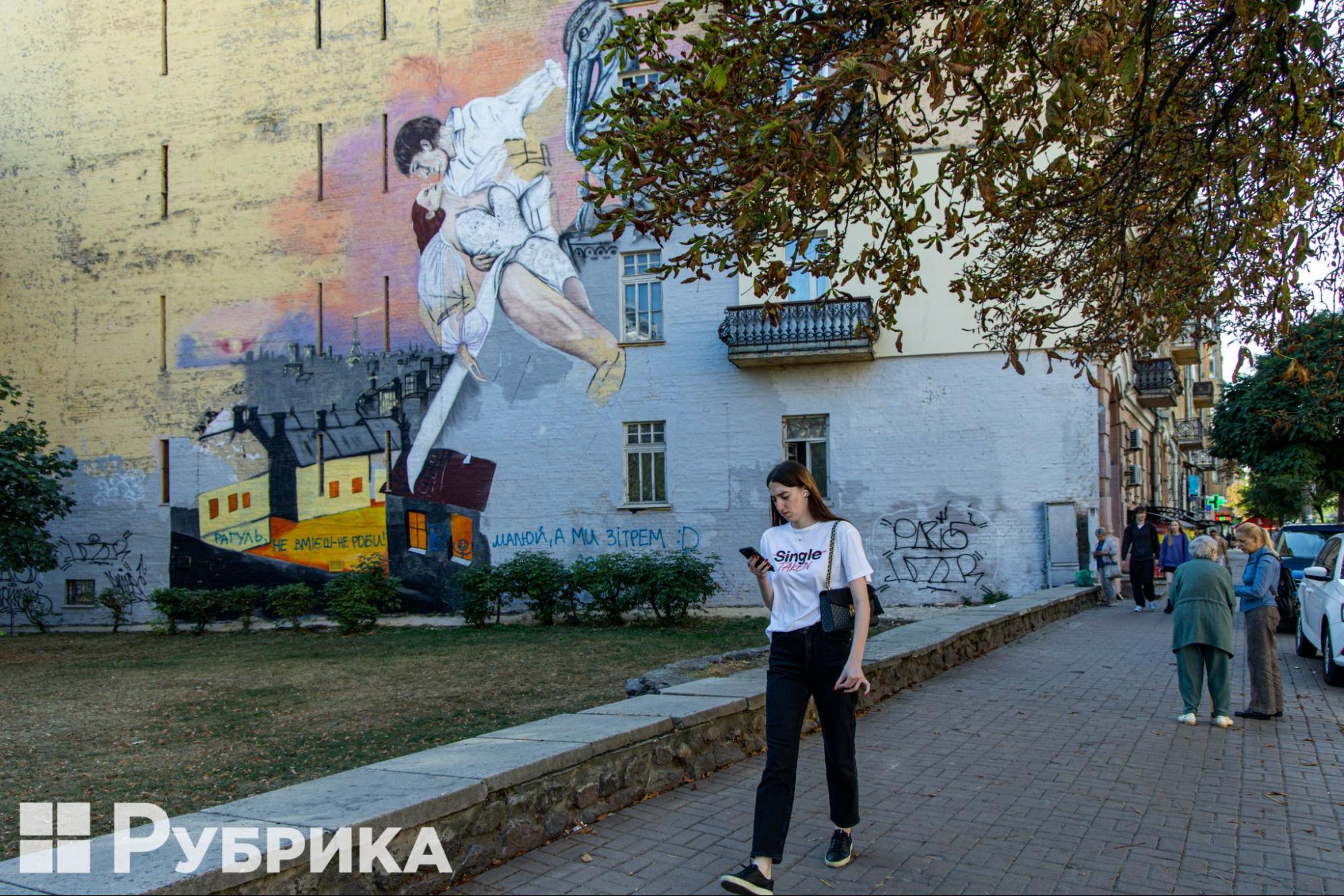
The unfinished mural on Sichovi Striltsi Street, 31.
"Since 2014, I have consistently written and spoken in lectures about the fact that this practice is harmful to our city, and it needs to be reviewed immediately," says Molyar.
In particular, the art historian in previous years spoke about the need for real, rather than formal, community involvement in making decisions regarding murals and the need for expert assessment of such works and the selection of their locations. She was strongly against the appearance of murals in the capital's city center, where the space has already been formed.
Molyar continues: "There were various projects then, including that of Geo Leros, who, together with representatives of the Kyiv City Administration, created a fairly large-scale project of painting Kyiv buildings with large murals. At that time, I found feedback from the public on my theses, but unfortunately, this was not heard by the Kyiv City Administration, as it actively participated in this process."
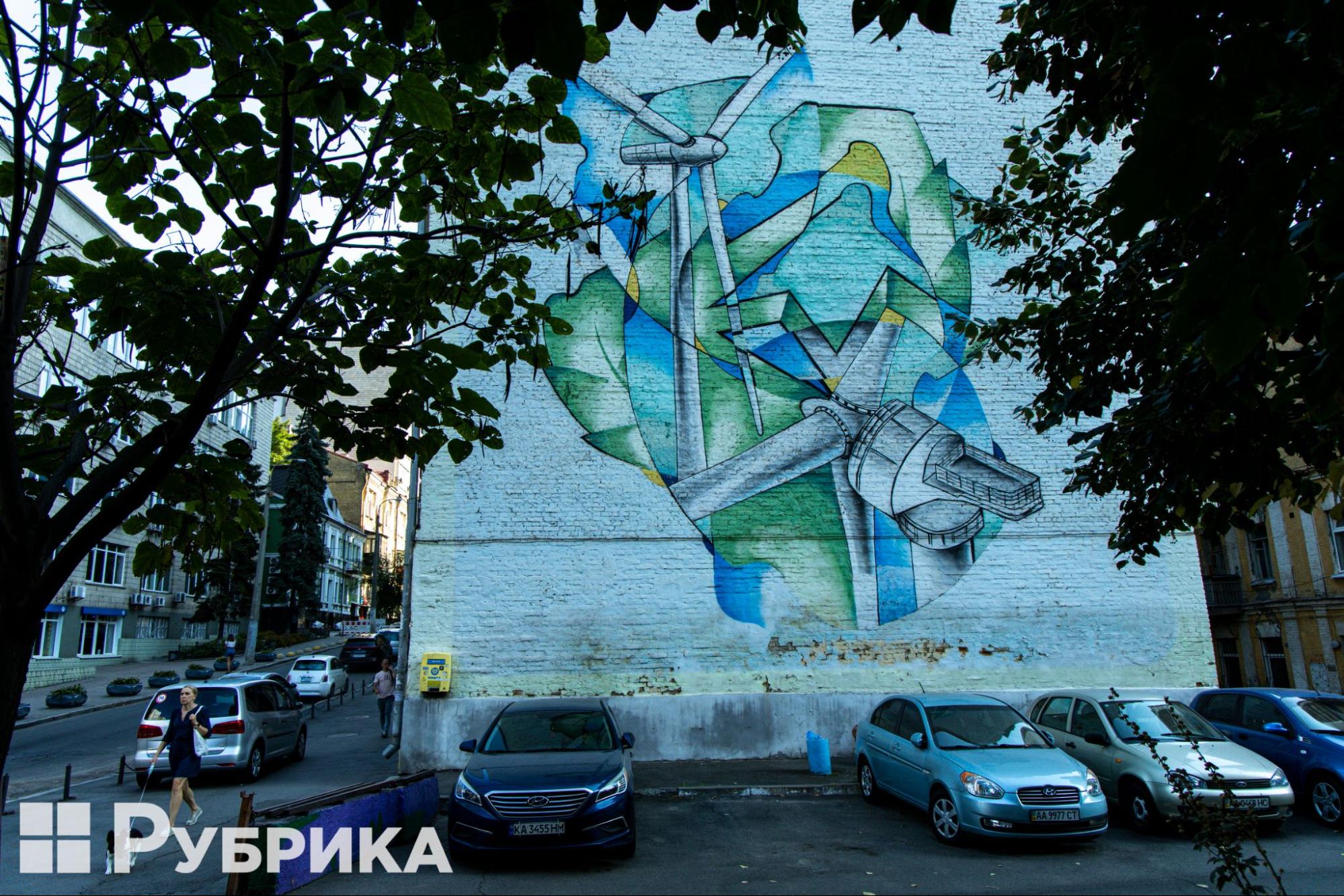
The mural "Windmills" was created in 2014 by artists Oleksandr Korban, Vitaly Dolhy (Ventel), and Roman Kuleshov (Wius) on the street Oleksandr Konyskyi, 35A. In one of the publications, Molyar wondered why a location in the city center with historical buildings was chosen for a mural on a super-modern theme.
That's why Molyar is very happy that these thoughts close to her have become popular, and many people have joined, including signing the petition. In her opinion, this is a significant step.
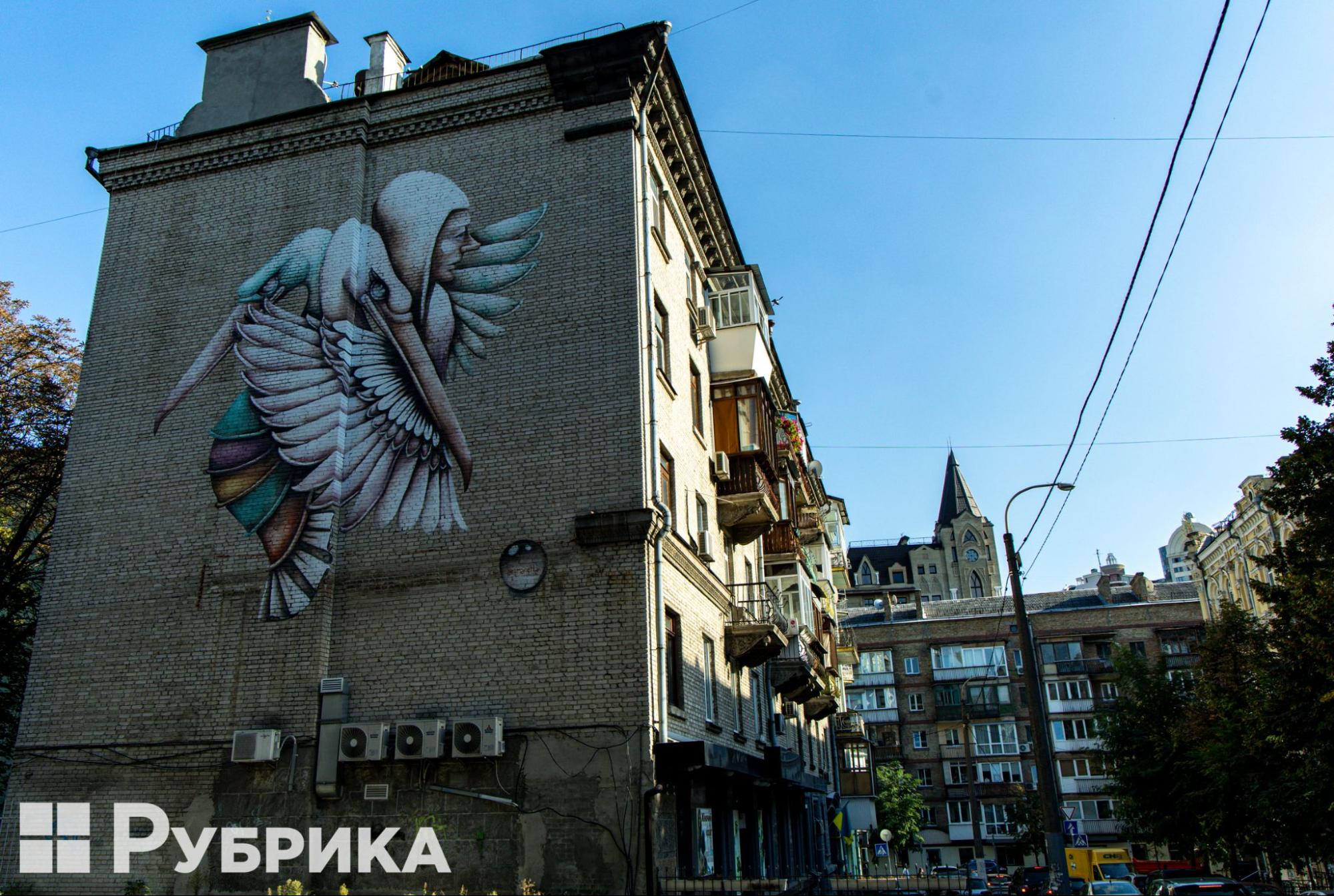
The mural "Embrace of Carefreeness" on Oleksandra Konyskoho Street was created in 2016 by the artist from Puerto Rico, Anoa Marietta.
"If we talk about international experiences, there is universal experience in regulating such projects. This includes the creation of expert councils, an expert commission, or a fund that would be involved in allocating the budget and determining the appropriateness or inappropriateness of creating one or another object in the public space," says Molyar.
The art historian is also impressed by the artist's active position, who vigorously defends her artwork. At the same time, Molyar calls for the conduct of such discussions to be ethical, without bullying and personal attacks.

Mural "Pavlo Skoropadsky" on Starovokzalna Street 12, was created by the company Kailas-V in 2015 as part of the CityArt project, curated by Geo Leros.
Other solutions
Remember the practice of "one percent"
The "one percent" system was a practice where a portion of the construction budget was allocated to create art objects. This can effectively promote art development and support artists in the context of new construction projects.
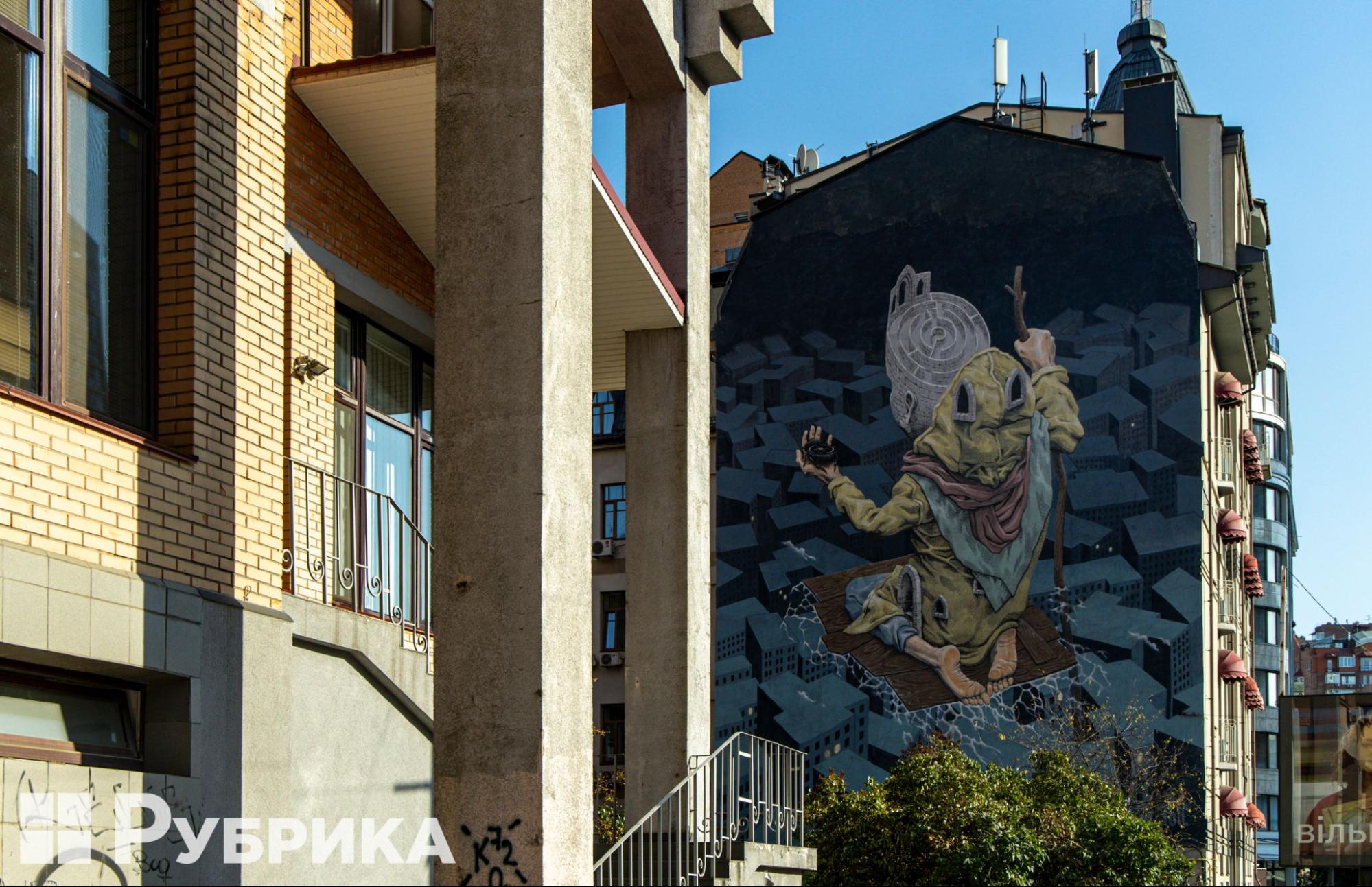
Mural "Labyrinth" (62/20 Anatoliya Kuznetsova St.) was created in 2016 as part of the Art United Us art project by the Russian artist Rustam Salemgaraev.
"Actually, such an example is not a relic of the Soviet period. Today, these practices are used in many European countries and the United States. This should be considered as a way to regulate the appearance of such works," suggests Molyar.
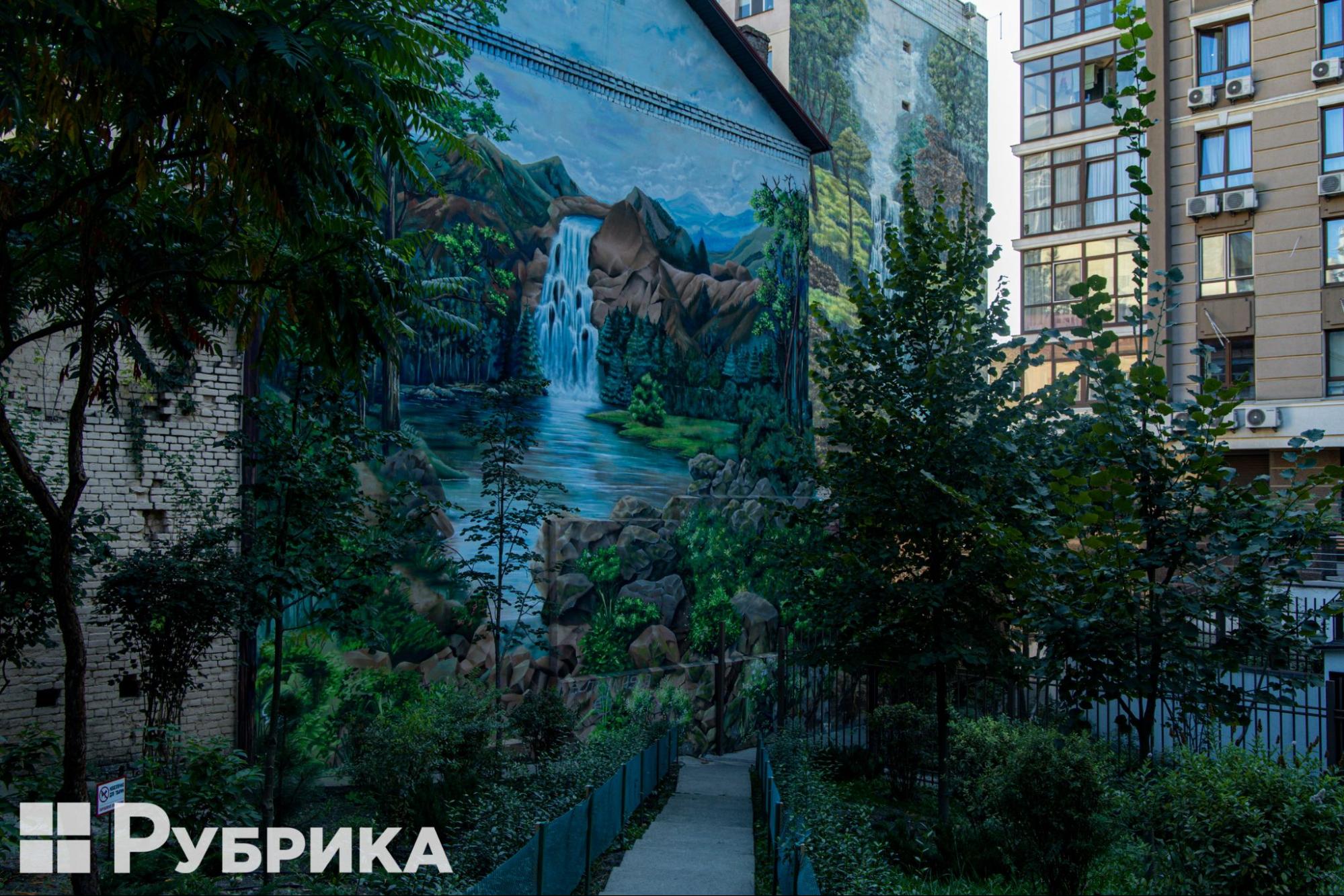
Mural (28 Zlotoustivska St.) was created in 2015 by the SprayWay art studio.
Murals have already become a regular part of Kyiv's urban space. Even walking routes are created with these murals, and there are many "tops" of such works in Ukraine and the world. For example, Rubryka made a navigator with the most striking murals of the capital as of 2018 and a selection of world murals in support of Ukraine. We have to decide together how artistic our urban space will be, considering experts' opinions. Today, opinions are different. So, the best solution for Kyiv murals is yet to come.
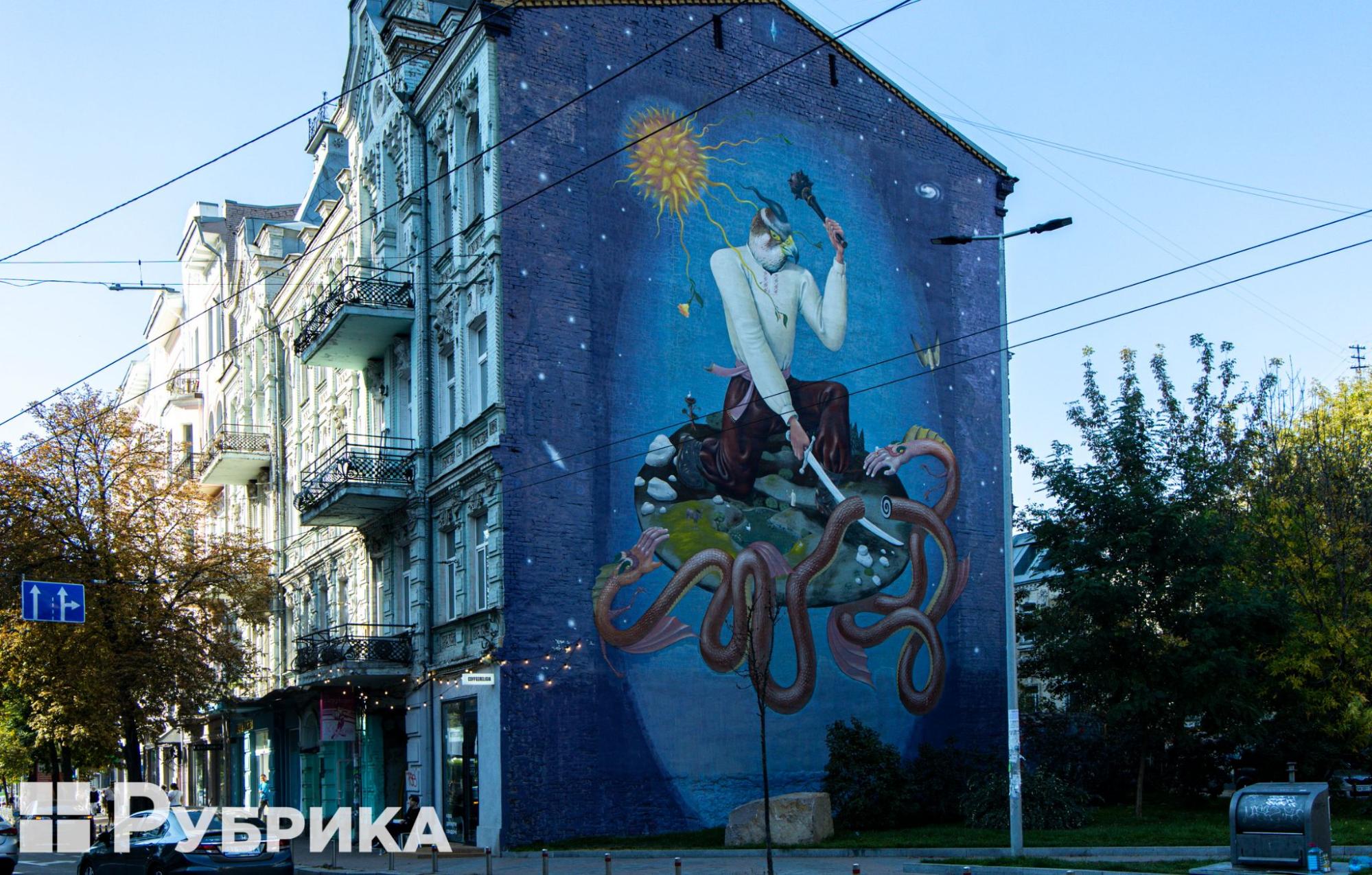
The mural "Saint Yuri" (38 Velyka Zhytomyrska St.) was created in 2014 at the initiative of the Ukrainian artist duo Interesni Kazki, which includes Volodymyr Manzhos (Waone) and Oleksiy Bordusov (Aes)
Mykola Tymchenko's photo shows wall paintings in the Shevchenko district of Kyiv.


